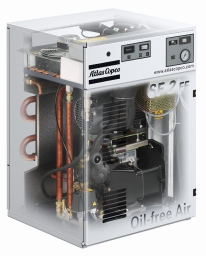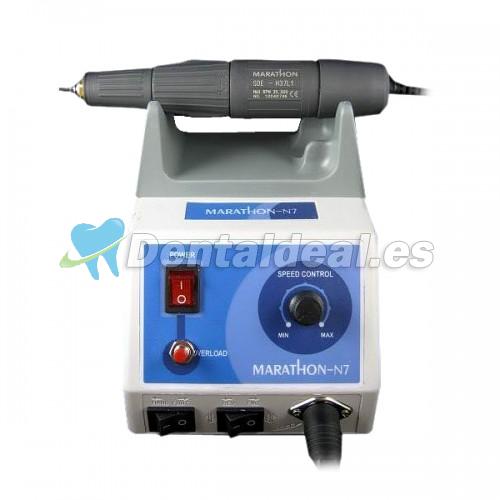
Dental scroll compressor. Photo: Atlas Copco
Besides producing clean air (no oil, no water), a dental compressor has some other features that are a must-have for many dentists.
As they are installed in a clean clinic, in a office-like environment (as opposed to an industrial environment), the compressor needs to be quiet, small and work on a standard 220 / 100 volt power outlet.
As the dentist will be busy with its everyday job of fixing peoples teeth, he won’t be very concerned with compressor maintenance. So a maintenance free compressor would be ideal.
When buying a compressor, also make sure that the output (the amount of air it can produce per minute or hour) is right for you. A too-small compressor will give you problem for the obvious reason that the pressure will drop when too many people use air at once.
But a too big compressor can also cause problems. If the compressor is so big that it only runs for 5 minutes a day, every other day, than problems with corrosion can occur, as the compressor never gets the chance to run for some time and get hot. It’s like when you lie in your bed all day for a year… you’ll get slow, lazy, tired.
Installation location: important!
A dental air compressor is typically installed in one of two locations: a small one inside each chair, or a big one in a central location.
Often, the location of the compressor is not given too much though. Many times it’s installed in a boiler room or basement. Don’t do this.
The quality of the air produced is as good as the quality of the air that is sucked in. In a hot, damp boiler room, or in a cold and damp basement, the chances of dirt water an bacteria growth in the compressed air system is much higher.
Install the compressor in a place where it can suck in clean air and where you can easily reach it for maintenance. Dental compressors are so quiet nowadays, that there is no need to hide it in the basement anymore.
Compressor permits
In some countries or states, a compressor permit is need when installing a compressor of certain size (for example a tank size of 100liters or more) or pressure rating (for example more than 13 bar) inside a residential area. Please check with your local authorities if this is the case in your area.
Certification
In some countries it is required that the dental compressor has the right cetfiication. For example TUV, CE, AOTC or ISPESL. Please check with your local authorities.
